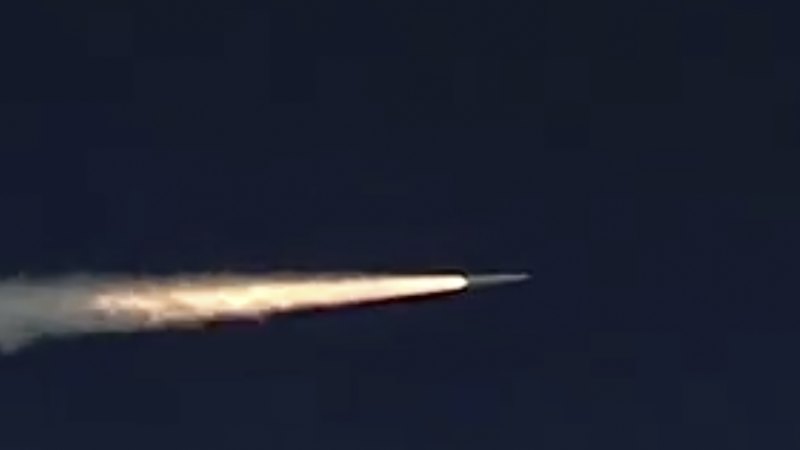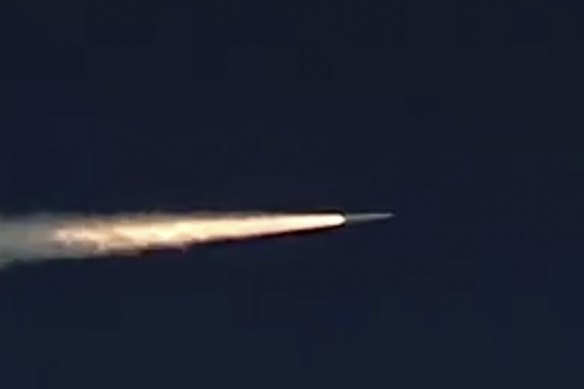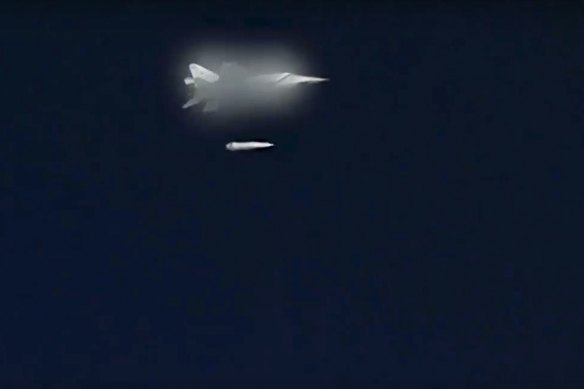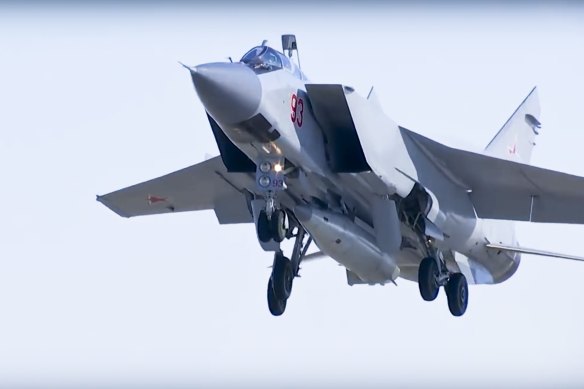Save articles for later
Add articles to your saved list and come back to them any time.
Key points
- This is the first time that Kyiv has claimed to shoot down multiple Kinzhals.
- Putin has touted the nuclear-capable missile as a world beater.
- Ukraine is girding itself for a big counteroffensive against the invasion.
- Europe is convening to discuss ways to hold Russia accountable for the war.
Kyiv: Ukraine said on Tuesday it had shot down six Russian Kinzhal missiles in a single night, thwarting a weapon Moscow has touted as a next-generation hypersonic missile that was all but unstoppable.
It was the first time Ukraine had claimed to have struck an entire volley of multiple Kinzhal missiles, and if confirmed would be a demonstration of the effectiveness of Kyiv’s newly deployed Western air defences.
A Russian Kinzhal hypersonic missile flies during a test in southern Russia.Credit: AP
Air raid sirens blared across nearly all of Ukraine early on Tuesday and were heard over the Ukrainian capital and the surrounding region for more than three hours.
“The enemy’s mission is to sow panic and create chaos. However, in the northern operational zone (including Kyiv), everything is under complete control,” General Serhiy Naev, Commander of the Joint Forces of the Armed Forces, said.
The six Kinzhals were among a volley of 18 missiles Russia fired at Ukraine overnight, lighting up Kyiv with flashes and raining debris after they were blasted from the sky.
It was not clear which Western weapon Ukraine used to defeat the Kinzhals. The Pentagon had no immediate comment.
An MiG-31 fighter jet of the Russian air force launches a Kinzhal hypersonic missile during a test in southern Russia. Credit: Russian Defense Ministry Press Service
For its part, Russia’s defence ministry claimed to have destroyed a US-built Patriot surface-to-air missile defence system with a Kinzhal missile, the Zvezda military news outlet reported.
But the commander-in-chief of Ukraine’s armed forces, Valeriy Zaluzhnyi, said all had been successfully intercepted.
Kyiv authorities said three people were wounded by falling debris.
“It was exceptional in its density – the maximum number of attack missiles in the shortest period of time,” Serhiy Popko, head of Kyiv’s city military administration, said on Telegram.
A MiG-31 fighter jet takes off carrying a Kinzhal hypersonic missile.Credit: Russian Defence Ministry
Zvezda quoted the Russian ministry as saying the attacks had been aimed at Ukrainian fighting units and ammunition storage sites.
Zaluzhnyi said his forces had intercepted the six Kinzhals launched from aircraft, as well as nine Kalibr cruise missiles from ships in the Black Sea and three Iskanders fired from land.
Earlier this month, Ukraine claimed to have shot down a single Kinzhal missile over Kyiv for the first time using a newly deployed US Patriot air defence system.
The US military confirmed that account but did not say whether the Russian missile was flying at hypersonic speed at the time of the intercept.
The US-based Centre for Strategic and International Studies (CSIS) says the Kinzhal rapidly accelerates to Mach 4 (4900 km/h) after launch and may reach speeds of up to Mach 10 – or 10 times the speed of sound. Hypersonic weapons travel at least five times the speed of sound.
“It is worth noting that Russia’s designation of the Kinzhal as a ‘hypersonic’ missile is somewhat misleading, as nearly all ballistic missiles reach hypersonic speeds (i.e. above Mach 5) at some point during their flight,” CSIS wrote on its website, describing the missile.
The Kinzhal missile, whose name means dagger, can carry conventional or nuclear warheads up to 2000 km. Russia used the weapon in warfare for the first time in Ukraine last year and has only acknowledged firing the missiles on a few occasions.
Russian President Vladimir Putin has frequently touted the Kinzhal as proof of world-beating Russian military hardware, capable of taking on NATO.
With Ukrainian forces preparing to go on the offensive against Russia’s invasion for the first time in six months, Moscow is now launching long-range air strikes at the highest frequency of the war.
It has launched eight drone and missile volleys so far this month, compared to weekly during the winter and a lull in March and April. Kyiv says it has been shooting most down.
Ukrainian troops have reclaimed about 20 square km of land around Bakhmut in recent days but Russian forces had advanced slightly in the embattled eastern city itself, Deputy Defence Minister Hanna Maliar said on Tuesday.
Maliar, who indicated previously that the Ukrainian advances around Bakhmut were not part of a broader counteroffensive, said on the Telegram messaging app that developments there “should not be taken out of context”.
She reiterated that Russia was sending in new paratroopers and added: “Heavy battles continue with different results.”
Moscow has acknowledged that some of its troops have retreated but denies that its battle lines are crumbling.
Kyiv’s counteroffensive is expected to take advantage of hundreds of modern tanks and armoured vehicles sent by the West, and mark the next major phase of the war after a Russian winter offensive that failed to take significant new territory.
Moscow mounted its full-scale invasion of Ukraine in February last year and now claims to have annexed around a sixth of its neighbour’s territory. Ukraine turned back Russian troops from the outskirts of Kyiv early in the war and recaptured territory in two counteroffensives in the second half of 2022, but has kept its forces on the defensive since November.
Russia says its invasion was necessary to counter threats to its security posed by Ukraine’s growing ties to the West. Kyiv and its allies call it an unprovoked war of conquest. Kyiv says it won’t stop fighting until all Russian forces leave its land.
On the diplomatic front, European leaders began a two-day summit in Iceland on Tuesday to focus on ways to hold Russia to account for its war. They are expected to approve a new Register of Damages that would record and document evidence and claims of damage, loss or injury incurred as a result of the invasion.
Reuters
Get a note directly from our foreign correspondents on what’s making headlines around the world. Sign up for the weekly What in the World newsletter here.
Most Viewed in World
From our partners
Source: Read Full Article








